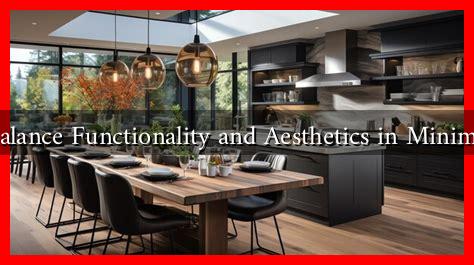-
Table of Contents
- How to Balance Functionality and Aesthetics in Minimalist Style
- Understanding Minimalism
- Strategies for Balancing Functionality and Aesthetics
- 1. Prioritize Functionality
- 2. Embrace Aesthetic Simplicity
- 3. Create a Cohesive Color Palette
- 4. Maintain Open Spaces
- Case Studies: Successful Minimalist Spaces
- Conclusion
How to Balance Functionality and Aesthetics in Minimalist Style
Minimalism is more than just a design trend; it’s a lifestyle choice that emphasizes simplicity, functionality, and beauty. In a world filled with clutter and distractions, minimalist design offers a refreshing approach that can enhance both our living spaces and our lives. However, achieving the perfect balance between functionality and aesthetics in minimalist style can be challenging. This article explores effective strategies to harmonize these two essential elements.
Understanding Minimalism
Before diving into the balance of functionality and aesthetics, it’s crucial to understand what minimalism entails. Minimalism is characterized by:
- Simple forms and clean lines
- Neutral color palettes
- Open spaces with minimal clutter
- Functional furniture and decor
According to a study by the American Psychological Association, environments that are clutter-free can significantly reduce stress and improve focus. This underscores the importance of both functionality and aesthetics in minimalist design.
Strategies for Balancing Functionality and Aesthetics
1. Prioritize Functionality
In minimalist design, functionality should always come first. Every item in a space should serve a purpose. Here are some tips to ensure functionality:
- Choose Multi-Functional Furniture: Opt for pieces that serve more than one purpose, such as a coffee table with storage or a sofa bed.
- Assess Your Needs: Before purchasing new items, evaluate what you truly need. This helps avoid unnecessary clutter.
- Incorporate Smart Storage Solutions: Use built-in shelves, under-bed storage, and hidden compartments to keep spaces organized.
2. Embrace Aesthetic Simplicity
While functionality is key, aesthetics should not be overlooked. Minimalist design thrives on beauty through simplicity. Consider the following:
- Focus on Quality Over Quantity: Invest in fewer, high-quality items that are visually appealing and durable.
- Utilize Natural Materials: Wood, stone, and metal can add warmth and texture to a minimalist space without overwhelming it.
- Incorporate Art Thoughtfully: A single piece of art can serve as a focal point, enhancing the aesthetic without cluttering the space.
3. Create a Cohesive Color Palette
A cohesive color palette is essential in minimalist design. Neutral tones can create a serene environment, while occasional pops of color can add interest. Here’s how to achieve this:
- Stick to a Base Color: Choose a base color for walls and larger furniture pieces, such as whites, grays, or beiges.
- Add Accent Colors Sparingly: Use bold colors in small doses, such as in throw pillows or artwork, to maintain balance.
- Consider Lighting: Natural light can enhance colors and textures, making spaces feel more inviting.
4. Maintain Open Spaces
Open spaces are a hallmark of minimalist design. They promote a sense of freedom and tranquility. To maintain open spaces:
- Limit Furniture: Choose only essential furniture pieces that fit the scale of the room.
- Use Area Rugs: Define spaces without enclosing them, allowing for a flow that feels open.
- Keep Surfaces Clear: Regularly declutter surfaces to maintain an airy feel.
Case Studies: Successful Minimalist Spaces
Several renowned designers and architects have successfully balanced functionality and aesthetics in their minimalist projects. For instance:
- Tadao Ando: His use of concrete and natural light in the Water Temple in Awaji Island, Japan, exemplifies how minimalist architecture can be both functional and beautiful.
- Marie Kondo: The tidying expert emphasizes the importance of keeping only items that “spark joy,” which aligns with both functionality and aesthetic appeal.
Conclusion
Balancing functionality and aesthetics in minimalist design is not only achievable but essential for creating harmonious living spaces. By prioritizing functionality, embracing aesthetic simplicity, creating a cohesive color palette, and maintaining open spaces, you can cultivate an environment that is both practical and visually pleasing. Remember, minimalism is about making intentional choices that enhance your life, so choose wisely and enjoy the beauty of simplicity.
For more insights on minimalist design, consider exploring resources like Minimalism.com.

